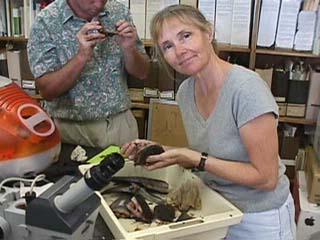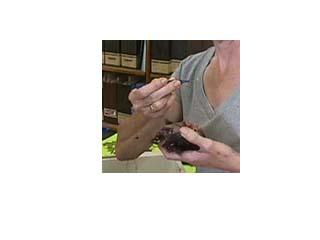30 July, 1999
Aloha from Hawaii,
I will be spending today and a few days next week in Dr. Radke's lab
learning the procedures for the field work in Greenland or as Kevin Kelly,
a graduate student on the project, affectionately says, cutting up fish
heads. I arrived at the lab in the late morning. The University of
Hawaii-Manoa is on the opposite side of the island, Oahu, that I live on.
Oahu is the most populous island of the Hawaiian chain and was nicknamed
long ago "the gathering place". You can visit the university on the
following web site, http://www.uhm.hawaii.edu .
Dr. Radke and I had worked together previously in a project that teamed
together students with physical dissabilities to regular education students
to study Kahana Stream which was located in the watershed near the high
school that I teach at, Kahuku High and Intermediate. Dr. Radke is a great
role model because he himself is a quadrapeligic who hasn't let his
handicap prevent him from being a research scientist. To know further about
this program please visit his web site at
http://pages.hotbot.com/kids/oceanofp/.
Dr. Radke and I disscussed our upcoming delay. We will be leaving a week
later that planned due a time when we could all meet in Greenland. Two
other researchers will be joining us, one from Canada and the other from
Norway.
Then Dave, Dr Radke's doctoral student, showed us how to dissect out the
otoliths. Each fish has 3 otoliths on each side of its body, right below
the brain. It took me an hour to get down to the brain cavity. I didn't
want to destroy the small pieces of bone that were the object of my search.
We also have otoliths in our inner ear and they serve the same function,
one of balance. There are crystals in these structures that move when we
change position like a rattle. This change in pressure is relayed to the
brain through nerves that are translated as a movement.
Finally I found the largest of the three structures, the sulcus on the
right side. They are a delicate whitish opaque structure that resembles a
tiny oyster shell. It was lodged in a small cavity under the brain. Then I
located a similar cavity on the left side of the head and inside was the
left sulcus. It was easier to find the second knowing where to look.
Kevin and I were both wondering how quickly we will be able to do this
when the temperature outside is 45 F. We were reassured that after the
50th fish we would be experts.
We looked at warm weather mittens and rubber gloves. I thought we might
have to cut out the fingers so we can do such delicate work. I was also
remembering how careful we were in Alaska not to throw foodstuffs around
the campsite and realize we will have to be especially careful with tissue
left after the dissections. Before I left the lab I washed my hands about
four times to remove the fish smells. And then I did a final dousing with
lemon juice, but on the way home I could still smell fish.

Kevin and I "cutting up fish heads".

See the tiny white otolith on the tip of my tweezers?
Contact the TEA in the field at
.
If you cannot connect through your browser, copy the
TEA's e-mail address in the "To:" line of
your favorite e-mail package.
|
